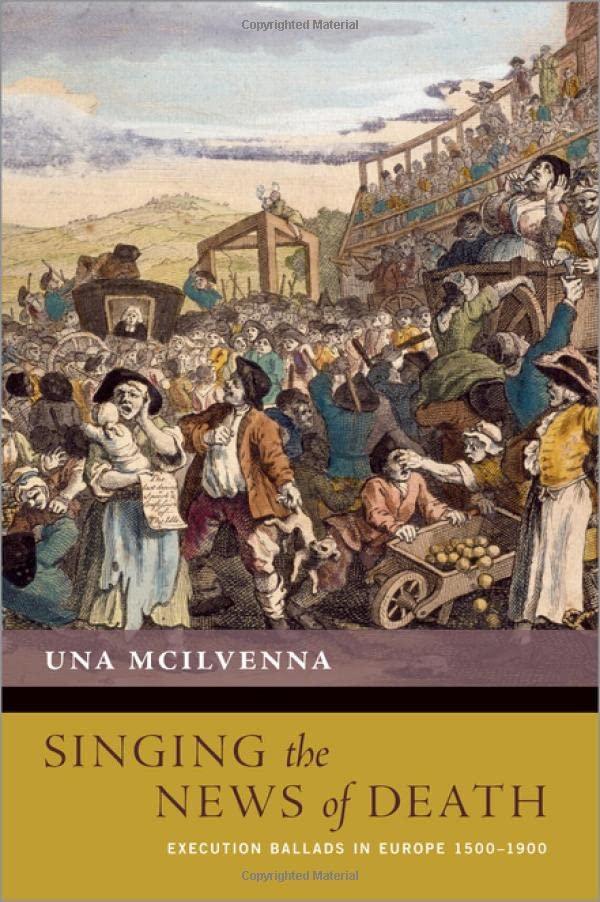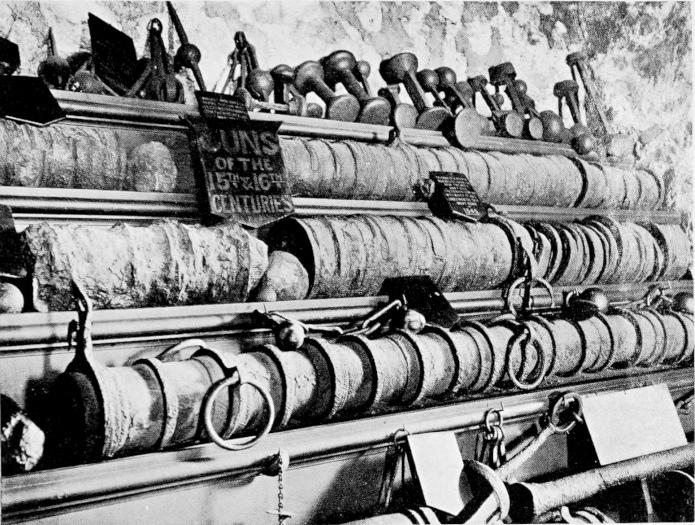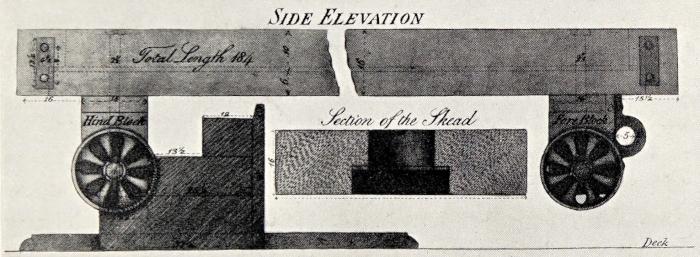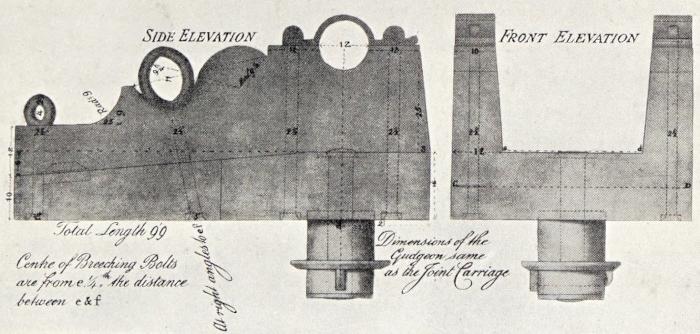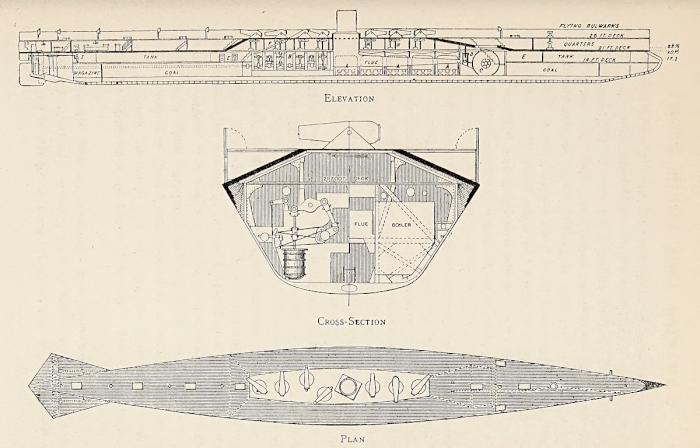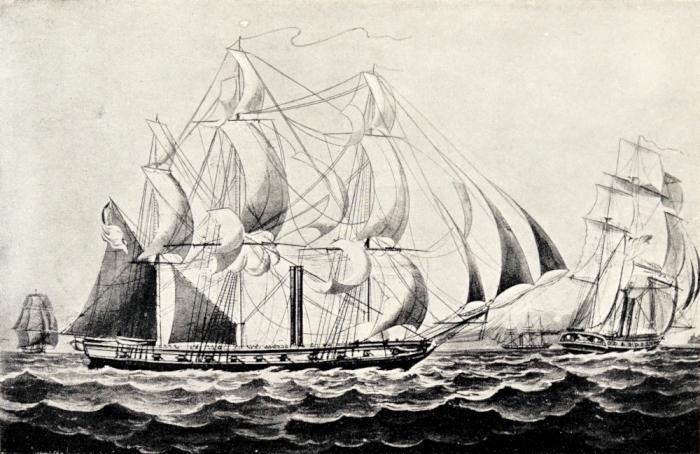Discovering Diverse Content Through Random Scribd Documents
better able to resist their shott. By this they are more subject to bee sunk by gunnshott than wee are.”
GUNS OF THE FIFTEENTH AND SIXTEENTH CENTURIES. In the Tower ofLondon.
ANCIENT DOUBLE GUN.
In the Museum ofthe RoyalUnitedService Institution.
The Mediterranean custom was different. The Marquis of Villafranca, whose advice was sought by Don John of Austria, thought there should not be more than two discharges before the galleys close, that the arquebussiers should not fire the second time until the blood of the man hit should splash back in their faces, and that the noise of the discharge should coincide with the ramming of the hostile vessel. But all the guns employed in the Mediterranean seafights were not of this order. In the tremendous struggle between the Cross and the Crescent much heavier artillery was used. One siege gun is said to have thrown a shot of 160 lb. During this struggle the Knights of Malta, after the capture of St. Elmo by the Turks, when the latter dishonoured the bodies of the slain knights, retaliated by beheading their Turkish prisoners and firing the heads back into the camp of the besieging Turks. The Knights combined unswerving fidelity to their principles and their masters, when they acknowledged any, with the utmost bravery, ferocity, and cruelty.
There was little to choose between the leaders on either side, but the palm must be given to the Mohammedan leaders for their fertility of resource in extricating themselves from apparently hopeless situations. The chief of these were the brothers Barbaroussa, one of whom made himself King of Algiers, and they and others of the band were the greatest of the Barbary pirates, dreaded from one end of the Mediterranean to the other. The elder Barbaroussa and his worthy successor, Dragut Reis, became the chief admirals of the Turkish forces, the latter being killed in that terrible struggle at Malta in which St. Elmo fell, a fate which was only averted from the whole fortress by the remarkable genius of the greatest commander the knights ever possessed. By way of commemorating the services of the brothers Barbaroussa, the present Turkish government has named after them the two secondhand German warships it recently bought. In the latter part of the seventeenth century the cannon were probably 42-pounders, the demi-cannon 32-pounders, and the culverins 18-pounders. Before an effort was made to systematise the armament of ships, hardly any two vessels carried the same number of guns. It was proposed in 1677 that a first-rate should carry twenty-six cannon with eight men to each; twenty-eight culverins, with five men to each; twenty-eight sakers on the upper deck, four on the forecastle, and twelve on the quarter deck, with three men to each saker; and two 3-pounders with two men each. A second-rate should carry twenty-six demi-cannon, with six men to each; twentysix culverins; twenty-six sakers on the upper deck and ten on the quarter deck; and two 3-pounders, with the same number of men to the guns as a first-rate. A third-rater should carry twenty-six demicannon, twenty-six 12-pounders with four men to each; four forecastle and ten quarter deck sakers, and four 3-pounders. The remainder of the complements was to consist of two hundred and ninety-six men, two hundred and sixty-two men, and one hundred and sixty-two men for the three rates respectively, giving grand totals of seven hundred and eighty men, six hundred and sixty men, and four hundred and seventy men.
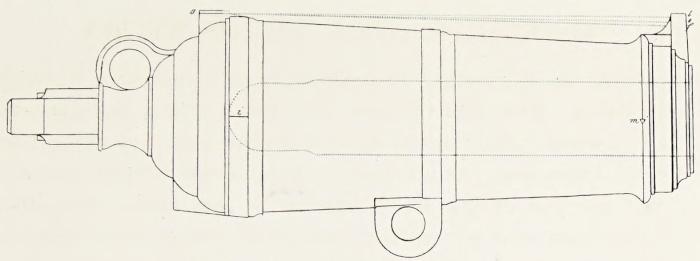
CARRONADE OF SIX DIAMETERS.
CARRONADE
THE CARRONADE AND ITS CARRIAGE.
From Drawings suppliedby the Carron Co.
About the beginning of the seventeenth century the practice was introduced and has been retained ever since—with the exception of the later guns, which are indicated by their weight or the diameter of their calibre—of describing the guns by the weight of their shot.
A remarkable advance in the science of gun-making was shown when the carronade was introduced by the Carron Company. Briefly, this weapon may be described as a short heavy gun, carrying a heavy shot, and using a moderate charge of powder. It was a wonderfully destructive weapon at short range, and as a broadside gun held its own well into the middle of the nineteenth century. A favourite carronade was that of six diameters, one of which is here illustrated; that is, the length of the bore was six times the diameter of the calibre at the gun’s mouth.
These guns were made in two or three patterns. One was the familiar swivel, another had the trunnions below the gun centre so that the gun rested upon them, and the third and most common was that with the trunnions at the sides. The carriages, too, were exceedingly ingenious, being devised to permit of meeting the recoil
as well as adding to the facility of handling the weapon, and the sighting arrangements did not leave the gunner much opportunity of going wrong provided he obeyed the instructions.
It was customary to fire a round, solid iron shot from these guns. On one occasion a very different missile was employed. An armed merchantman was overtaken by a privateer, and being short of cannon balls, the cargo was broached. The first missile hit the side of the privateer and smashed. The second hit a mast, dented it, and flew to pieces. Another missile smashed itself and a privateersman’s head at the same time, and the enemy then hauled off, wondering what new projectile had now been discovered. The merchant ship had defended itself with round Dutch cheeses—a testimony alike to the ingenuity of her commander and the strength of the missiles.
The East India Company had several vessels built in the Far East, and great was the outcry at the proposal that Indian-built ships should be included in the British Navy. However, the success which attended the armed ships of the Company, such, for instance as the Grappler, launched at Bombay, in 1804, was responsible for the launch of a “beautiful frigate” at Bombay, called The Pitt, the first ever built in India for His Majesty’s service.[26] A picture of her is in the Guildhall Museum, London.
The merchant vessels of the East in the seventeenth century were usually built of teak and well armed, and if they were not particularly fast sailers—some were particularly slow—they were usually able to withstand the shot of all but the heaviest guns which the pirates and privateers carried who infested those seas. Some of the greatest French naval heroes were men who were dreaded from one side of the Indian ocean to the other.
One of the vessels constructed in those days and still afloat is the sailing ship Success, which, after an eventful career, was one of the “floating hells” in which convicts were imprisoned near Melbourne for some years, then became a coal hulk, was somehow saved from destruction when her equally evil companion ships were ordered to be broken up, was turned into an exhibition ship showing her as a
prison ship, was scuttled in Sydney harbour, raised again, and has since toured the world. She saw active service about a hundred years ago, and still bears on her tough sides the marks of the enemy’s cannon balls. She is probably the last of her type afloat. The East Indiamen and the West Indiamen of the seventeenth and eighteenth centuries invariably carried guns, and needed them.
It is strange to think how recently the policing or safety of the seas has been secured, for the Liverpool newspapers contained, even in times of peace, advertisements that vessels would sail with the convoy, and that such and such a warship would act as escort.
Even along the British coasts the Carron Company armed its schooners, and offered special inducements to those passengers who were willing and able to assist the crew to repel a possible attack.
CHAPTER IV
STEAM AND WARSHIPS
THE use of the steam engine as a propellant had been established in the mercantile marine long before the British Admiralty led the way in the adoption of the steamship as an engine of war. There were several reasons why the decision to take the important step was not reached earlier. In the first place there was a repugnance, amounting with many persons to an unconquerable aversion, against the use of the steamship for any purposes whatever. Steamships were regarded as unsightly with their splashing paddle-wheels and their high funnels belching forth smoke, and as the steam mercantile marine had been by no means free from boiler explosions and had lost many vessels through fires caused by sparks or cinders from the furnaces, or the overheating of wood work near the flues, it was argued that the introduction of so many fresh dangers into the country’s fighting ships would only add to the perils of the sea, which were already serious and numerous enough.
The navy possessed many fine wooden ships which could be handled extremely smartly under sail and presented a magnificent contrast and beautiful picture compared with the smoky steamer. The latter, it was graciously admitted, might have its uses in towing the sailing warships, but that anything further should be advocated was too subversive of all that had gone before; too revolutionary, indeed, to merit a moment’s consideration.
It was in vain that the advocates of the adoption of steam propulsion urged that the steamship could carry guns, that she would be independent of wind and tide, and that she could choose her own position. These strategical advantages were simply derided. What, it was asked in reply, could a small steamship armed with such guns as she could carry, do against a battleship; or, for that matter, what
could any number of armed steamships do? When it was pointed out that an armed steamship could engage with every advantage an enemy’s ship of the same size, the retort was that a battleship would never be far off. Strange though these objections seem to us in the light of subsequent events, it must be recollected that marine steam engines in those days were bulky for their power and weak for their weight, and consumed an enormous amount of coal for the energy developed, and that there was no room to spare in the fighting ships of the period; also, that the steam engine was not far removed from the experimental stage. For the first twenty-five years of the nineteenth century the Admiralty had every excuse for the maintenance of its conservative attitude.
In America, also, the objections to steam war vessels were as acute as in this country. One United States secretary of the navy declared that he would never consent to see the beautiful sailing warships displaced by hideous and smoky steamers, but the advocates of the new method of ship propulsion were not of his opinion, and so worried the worthy man that in despair he wrote to a sympathetic friend, “I am steamed to death.” Another and earlier American administrator was so opposed to warships of any kind, or at least to spending much money on their construction, that he conceived the brilliant idea of having some small gunboats built which could be taken overland from port to port and launched afresh, when necessary, to oppose the British warships. It is a pity he could not have derived some inspiration from the invention of Oliver Evans, an American, who in 1804-5 designed a dredger which bore the terrible name of Orakier Amphibolos; it had a steam engine of some sort, and propelled itself on wheels from the shed where it was built, to the Schuylkill, a distance of a mile and a half, and being fitted with a paddle wheel in the stern, navigated the river to its junction with the Delaware.[27]
France, like England, was disposed at first to look upon the steam engine as useless for naval purposes, and until well towards the middle of the nineteenth century she was a long way behind
England in the application of steam power to the navy. Many of the smaller nations, however, having but a few insignificant sailing ships for war, were not trammelled, as were England and France, by the possession of a large fleet of wooden sailing vessels of types which had helped to build up the national renown, nor had they to contend against the energy of a powerful section of the community which, conscious of what had been accomplished with the sailing warships, despised anything else and hated innovations. The smaller nations were the better able, therefore, to experiment with warships of the new type than were the great maritime powers, and one or two of them ordered small steamers carrying a few small guns. These were mostly converted merchant steamers, it not being until after England and France had definitely adopted steamers that the other nations ventured to possess steamships specially built for purposes of war. But when steam navigation had become an accomplished fact and steam-propelled vessels were able to undertake ocean voyages, there was the less excuse for the absolute rejection of steam-driven ships for war purposes. The objections raised, and they were certainly serious, were that the paddle-boxes were large and increased the size of the target at which the enemy could aim, that one or other of the paddle-wheels could easily be disabled by a hostile shot, in which case the steamer would be almost helpless, and would be entirely so if both wheels were disabled; that the engines and boilers, being partly above the water-line, were peculiarly vulnerable, and that the only vessels of a size capable of being propelled by paddle engines were too small to be of much fighting value.
Long before steam engines were adopted in any form in the navy, numerous experiments had been made in the mechanical propulsion of warships, and some extraordinary methods were brought forward. The remarkable feature of nearly all these experiments is that they would propel a vessel; but the inventors could not be taught, except by the bitter lesson of experimental failure, that an appliance which might attain a certain measure of success with a small boat or a model might be incapable of developing sufficient power to propel a
larger vessel. Several inventors, both in this country and America, tried what they could do with oscillating paddles at the stern. Manual power was tried on the frigate Doncaster at Gibraltar, in 1802, to drive a “perpetual sculling machine,” invented by a man named Shorter, and a speed of something under two miles an hour in still water was obtained.
Certain of the early experiments in America had an important influence upon the development of the steam warship, though the proof of that influence did not become evident for many years.
Colonel John Stevens, who had a small, screw-propelled steamboat on the Hudson, in 1804, and a twin-screw steamer in the following year, designed, in 1813, an iron-clad ship which fully embodied the Monitor type, and was the first ironclad ever worked out for construction. It was Stevens who sent the first steamer on a sea voyage; his vessel, the Phœnix, being shut out of the waters of New York by the monopoly which Fulton and his friends had secured, went round to the Delaware by sea in June, 1809, experiencing a gale on the way, which compelled her to seek shelter in Barnegat Inlet.
Of Fulton’s early experiments and failures in the matter of submarines and torpedoes it is unnecessary to speak. In 1814, some years after his return to the United States from Europe, where he had been impartially offering his services to the French and then the British, he submitted to the American coast and harbour defence committee plans for a steam warship which was to carry a large number of guns.
The boat was launched in October of that year and given the pedantic name of Demologos, which was simplified to Fulton the First. The war ended before the vessel could be tested, and she became a receiving ship. Her machinery was arranged to drive a large paddle-wheel, placed amidships and working in a tunnel in the hull. She was to carry twenty guns, not forty-four as sometimes stated, and furnaces for red-hot shot, and was to travel at a rate of four miles an hour. Besides her deck armament it was proposed that
she should have two submarine guns suspended from each bow, which were to send a hundred-pound ball into an enemy’s hull ten or twelve feet below the water-line. Her machinery was intended to pump a tremendous column of water upon the enemy’s decks and through the latter’s portholes. Her gun-deck was completely covered over so that no hostile shot could reach it from above. Her wooden walls were five feet in thickness, and capable of withstanding the heaviest shot of the day. The dimensions of this remarkable craft were: length, 156 feet; beam, 56 feet; and depth, 20 feet; but her draught, loaded, was only 10 feet. The water-wheel, the position of which is indicated in the centre of the accompanying plan of the gun-deck, was 16 feet in diameter, and had blades or buckets measuring 14 feet with a dip of 4 feet. The cylinder of the engine measured 48 inches, and the stroke was of 5 feet. The boiler was 22 feet long by 12 feet beam, and 8 feet deep. The gross tonnage of the vessel is set down at 2,475 tons. The ship was two-masted, and could steam either end foremost. She was built at Brown’s yard at New York, in four months after her keel was laid, and given her machinery and guns at Fulton’s works on the North River.
Another vessel, destined like the Demologos never to see active service, but which, nevertheless, was the first iron-clad steamer actually built, was the ship designed, in 1841, by Edwin A. Stevens, a son of John Stevens, at the time that hostilities were feared between England and the United States.
Mr. J. Elfreth Watkins, in an address before the Philosophical Society of Washington, in 1892, said:—“As thick armour plate could not be made at that date, he devised the method of armour plating in laminæ, or plates laid over each other and riveted. He then made a series of experiments to determine the thickness of plating required to resist the different sizes of balls then in use. From these experiments, which were made at Bordentown, N.J., in the summer of 1841, he made the deduction that a target of iron 4½ inches thick would resist a 64 lb. shot, at that time the heaviest ball used in our navy.”
This standard of thickness was afterwards adopted by European naval architects for warship iron armour.
A committee of naval and military officers was appointed which made numerous tests, and as a result Congress entered into a contract with Stevens for the construction of “a war steamer, shot and shell proof, to be built principally of iron,” and making an appropriation for the purpose.
Up to this time there had been but little change in the power of guns since the time of Nelson, but Commodore R. F. Stockton’s successful construction in England of a wrought-iron gun throwing a round shot able to pierce a target 4½ inches thick, induced Robert Stevens, who was associated with Edwin A. Stevens, to alter the plans and increase the thickness of the armour so as to fulfil his contract to build a ship that should be “shot and shell proof.”
The production of still more powerful guns, both in America and Europe, caused more alterations and delay. It is of interest to note the dimensions of this vessel in order to see to what an extent Stevens anticipated the designs of some later engineers. When Robert Stevens died, in 1856, the ship was then 410 feet long, 45 feet inside the armour shell, with two feet of freeboard, and with a square, immovable turret enclosing depressible guns. She had her engines and boilers, and it would not have taken long to complete her; but for some reason, which need not be gone into here, except that the vessel was too far in advance of the officials at Washington, who were wedded to wood and sail, she was never launched, and was ultimately sold in 1881 for old material. Besides being armoured and turreted, she had a powerful ram of the “axe-head” pattern.
THE STEVENS BATTERY.
(click image to enlarge)
A writer in the Cosmopolitan Magazine for May, 1898, says:—“That the Stevens battery would have been irresistible as a ram and invulnerable as a fort is easy to be seen; but the Stevenses were condemned in this case by official obstruction to undeserved failure.... During these years, though constantly undergoing alteration and reconstruction, she was at all times in a condition which would have admitted of her rapid completion had an emergency arisen, on the plans which were for the moment being carried out, and these plans were always so far in advance of general naval construction that if so finished she would have been a match for a fleet of the best vessels of the world at the same time. Thus, while the naval armament of the world was light, her original armour of 4½ inches would have rendered her invulnerable to the shot of an enemy, while her shell guns would have meant certain destruction to any vessel not provided, like herself, with an armour capable of keeping out such shells. As the size and penetrating
power of cannon shot were increased, so was the provision for heavier armour made in the Stevens battery, and her own guns were at the same time enlarged in the successive designs.” This refers to the period immediately prior to the American Civil War.
Another Stevens invention was that of the air-tight fire room, by Edwin A. Stevens, in 1842, whereby forced draught was rendered effective.
Colonel John Stevens, in 1812, designed a steam-rotated circular fort for the defence of New York Harbour, and a year or two later, his son, Edwin Stevens, under the guidance of his father, was experimenting with a 6-pounder bronze cannon against some iron plating. The elongated shell, with which the name of Stevens is always associated, was invented by Robert L. Stevens during the war between England and America in 1813-4. The shell could be fired from ordinary cannon.
THE “RISING STAR.”
From a Painting in thepossession ofthe EarlofDundonald.
(click image to enlarge)
“Having perfected this invention, he sold the secret to the United States after making experiments to prove their destructiveness, so decisive as to leave no doubt of the efficacy of such projectiles. One of these experiments was made at Governor’s Island in the presence of officers of the army, when a target of white oak, four feet thick and bolted through and through with numerous iron fastenings, was completely destroyed by a shell weighing 200 lb., and containing 13 lb. of best Battle powder. This solid mass of wood and iron was torn asunder; the opening made being large enough, as the certificate of the officer commanding, Col. House, stated, for a man and horse to enter. These shells are free from the danger accompanying ordinary shells, for they are hermetically sealed and suffer no deterioration from time.”[28] Some of them, indeed, were fired experimentally twenty-five years after they had been made and were found to be as effective as similar shells fired soon after they were loaded.
It cannot be said that the British Admiralty was not forewarned. Even at the time of Fulton’s experiments, Lord Stanhope, who was interested in the subject, wrote to Wilberforce that “when ships of any size may be navigated so as to go without wind and even directly against both wind and waves ... it will shortly render all the navies of the world (I mean military navies) no better than lumber.” He pointed out that ships independent of wind and weather were superior to sailing ships, and that “the boasted superiority of the British navy is no more.” A new navy was necessary, and the French and other nations for the same reason would have one. His lordship proved himself a true prophet so far as the other nations were concerned, for the British Admiralty was about the last to adopt steam-driven battleships; but as to the rest of his prophecy, Trafalgar had not then been fought. When steam navigation came, it came to stay.
But though the Admiralty hesitated, others did not. Probably the first steam-driven ship of war which ever went to sea, though not the first mechanically propelled war vessel—the Far East, as we have seen, ante-dating us in this matter by a couple of centuries—was the RisingStar. She was certainly the first to traverse the waters of the Atlantic from north to south, and the first steam warship to round Cape Horn and pass into the Pacific.
The RisingStarwas a remarkable ship in many ways. She was built at Rotherhithe for the tenth Earl of Dundonald when, as Lord Cochrane, he was engaged by the Chilian Government to create and take command of the Chilian navy, and stipulated that a steamship should be built as the best means of neutralising the difference between the Chilian and Spanish naval forces. The Rising Star was really taken out by Major the Hon. William Cochrane. Owing to various vexatious delays in construction, she did not reach completion in time to permit of her arrival in time to participate in the war, the energetic Admiral Cochrane having, in the meantime, disposed of the Spanish fleet with his customary thoroughness. The ship was begun at Kier’s yard in 1820, and arrived at Valparaiso in
April, 1822. How she was propelled is a matter of conjecture. At one stage of her career she had paddles of some sort, and also paddlewheels, but when she finally left England a different system altogether appears to have been adopted, which seems to have been an application of the jet method, by which the ship is propelled by forcing out of streams of water through apertures in the hull below the water level.
The RisingStaris shown in a contemporary engraving of her to have been a full-rigged ship, without royals, and carrying, besides the ordinary square sails of her rig, peculiarly shaped square-headed staysails between the masts.
This vessel has been referred to in several books as the RisingSun; it is as well that the error be corrected and her right name given. The statement that the RisingSunwent to Chili for Lord Cochrane in 1818 is erroneous, though often made both in this country and in America.
The Admiralty thought so little of steam engines at first that it did not trouble to record the names of its early steamers in the navy list. Owing to the representations of Marc Isambard Brunel, the Admiralty consented to try steam, and experimented with two small paddleboats, the Monkey, built at Rotherhithe in 1821, and the Comet, built at Deptford in 1822, which were acquired to be used as tugs or despatch boats. The former was a vessel of 210 tons, and had engines of 80 nominal h.p.[29] by Messrs. Boulton and Watt. The two cylinders were each about 35½ inches diameter, with a stroke of 3 feet 6 inches, and, working at 26½ revolutions per minute, gave a mean piston speed of 185 feet per minute. It will be interesting and instructive to contrast these figures with those of the latest engines in warships, which will be found in another chapter. The Active and Lightning followed in 1822 and 1823 respectively, their names appearing together with a few others for the first time in the official navy list for March, 1828.[30] None of these steamers, however, could be classed as war vessels. From this year to 1840 seventy other steam vessels were added to the navy. All the early steamers
were built in private yards, and the contractors had even to provide the engine-room staffs, which were taken over together with the steamers. By 1832, the Admiralty bestirred itself and built its first steamer, the Salamander, but until 1840 none was over 1,000 tons, and all were of wood, propelled by paddle engines, and such guns as some of them carried were small and ineffective. With the increase of the size of the vessels came a more than corresponding increase in the power of the engines. The Rhadamanthus, for instance, built in 1832, had engines capable of being worked up to 400 indicated h.p., though they were of 200 h.p. nominal. The safety valves carried a load of 4 lb. to the square inch, and the total weight of the machinery was 275 tons. In 1839, five wooden steamers were built for the Admiralty, and two of them, the Hecla and Hecate, of 817 tons, and 250 h.p. each, were sent to Scott’s, at Greenock, to be engined, and were the first naval vessels to have their machinery fitted on board in Scotland.
But when men like Brunel, Scott Russell, and Laird of Birkenhead, were loudly advocating the adoption of steam-propelled war vessels, and the steamers were proving their superiority over the sailing ships in every respect, the Admiralty was compelled to pay attention. These men also urged the adoption of iron in place of wood for shipbuilding. The idea was ridiculed. It was in vain that it was pointed out that, though a piece of iron would sink and a piece of wood of the same size would float, the true test of buoyancy lay in the total weight of the material used in the construction of a hull, and that a hull of given external dimensions and built of iron would be more buoyant than a hull of the same dimensions and built of wood, and that the difference in favour of iron amounted to as much as 20 to 35 per cent.
The mere fact that iron steamers were already in existence had little influence with the Admiralty. The first of these was the Aaron Manby, built at Horsely in 1821, for Captain (afterwards Sir) Charles Napier and the gentleman after whom she was named. Others were doing service in Ireland. In 1832, Messrs. McGregor, Laird and Co. had the Elburkahconstructed for employment on the Niger; she was
70 feet long, by 18 feet beam, and 6 feet 6 inches depth. Two years later Mr. Laird built at Birkenhead the GarryOwen, a little vessel only 125 feet long and fitted with two engines of a total of 90 nominal h.p. She went ashore during a gale on her maiden voyage, having as companions in misfortune several wooden vessels, and was the only one to be refloated, being little the worse for her misadventure. This proved the strength of an iron-built ship beyond doubt, and iron coasting steamers after this became comparatively numerous.
The first iron warship, a frigate, was proposed by Laird in 1836, and built at his yard at Birkenhead in 1842; it was offered during construction to the Admiralty, which would have none of it, so it was sold to the Mexican Government, which christened it the Guadeloupe. This vessel was 175 feet in length, by 30 feet 1 inch beam, and had a depth of hold of 16 feet.
The East India Company appreciated the value of iron steamers suitable for war purposes, and placed an order with Laird in 1839. One of those, the Nemesis, built under this order, went to India via the Cape, and took part in the China operations in 1840-2. She was struck several times by cannon balls and holed. Her commander, Captain Hull, reported in his evidence before the Royal Commission, in 1848, on the naval estimates, that the holes were made clean and without splinters, thus disposing of the theory that iron when struck by a shot would splinter worse than wood. Her armament consisted of two 32-pounder pivot guns so mounted as to give her a wide range of fire, and as she drew but five feet of water she may be regarded as the first of the shallow river-gunboats which have done such excellent service in so many parts of the world.
Meanwhile Francis Pettit Smith in this country had adapted the screw propeller to steam navigation, and after one or two experimental boats had been successful, the Archimedes, fitted with a screw propeller of his design, made her memorable journey from port to port of the British Islands in 1838. The Novelty, a slightly larger vessel, of 117 feet in length, was launched the next year, both coming from the yard of Mr. Wimshurst, at Blackwall.
About this time Ericsson brought out his screw propeller, and having equipped a small steamer with it, towed the Admiralty barge a considerable distance upon the Thames with the Lords of the Admiralty on board, besides making other experiments, all of which were not without a fair measure of success. The navy officials were not convinced, however, that the application of the power at the stern was of practicable value for warships. So Ericsson went to America, and devoted his remarkable inventive genius to the welfare of his adopted country. Had he remained in England, and had his inventions been taken up by the Government, the history of the ’sixties might have been very different, for it was he who designed the Monitor, the small turret ship which prevented the Confederates from obtaining the command of the sea in the American Civil War.
In 1841, he accepted an order from the United States Government to furnish the designs for a screw warship, the Princeton, this being the first vessel which had the machinery wholly below the water-line and out of reach of an enemy’s shot. This vessel is claimed by Americans to have “dictated the reconstruction of the navies of the world.”[31] Several mechanical novelties and contrivances strange to warships, and for the most part owing the form in which they were introduced into this vessel to the fertile brain of the inventor, made their appearance in the Princeton. She had a direct-acting, semicylindrical steam engine of great compactness and simplicity, independent centrifugal blowers for ventilating the machinery compartment and assisting the combustion in the furnaces, so as to avoid the exposure during an engagement of the smoke stack which, as a greater measure of safety, was made on the telescopic principle. The 12-inch wrought-iron gun, with which the vessel was armed, was the first of its kind, and was at that time the largest and most powerful weapon afloat. He designed the wrought-iron gun carriages, and provided them with contrivances for dispensing with breeching and taking up the recoil. There were also an optical instrument to enable the commanding officer by mere inspection accurately to ascertain the distance of the object to be aimed at.
The Admiralty relented towards iron for shipbuilding in 1840, when it had the paddle-steamer Dover built at Birkenhead, and three small iron gunboats followed from the same establishment before the end of the year. The demonstration afforded by the Garry Owen has been alluded to. The Great Britain, that magnificent pioneer of the iron screw steamship, launched at Bristol, in December, 1844, ran on the rocks at Dundrum Bay on the coast of Ireland, in 1846, and was successfully refloated after being ashore for nearly eleven months, during which she withstood several severe gales. After this it was no longer possible either to ignore the superiority of iron over wood for constructional purposes, or to doubt the immense strength with which an iron ship could be built.
The enterprise and daring of Brunel in designing this ship without any data to go upon stamp this vessel as an evidence of his extraordinary genius. She was in a sense the forerunner of the Great Eastern, for she demonstrated what could be done with iron; and the GreatEastern, constructed on the longitudinal system, though a commercial failure, proved the advantages of that system for vessels of such remarkable length, as to a large extent her design solved the problem of overcoming the sagging and hogging strains and showed the Admiralty what could be achieved in contending with this difficulty. This success helped in no slight degree to the introduction of the iron-clad citadel system some years later.
The success of the Archimedes and the Great Britain demonstrated the power of the screw, and in the latter that iron must be the material for future ship construction, whether in the navy or the mercantile marine. The Government clung to wood for all its fighting ships as long as it could, but it decided to try the screw propeller, without, however, abandoning the paddle-wheel, and many fine vessels were launched.
Before this, Messrs. Ditchburn and Mare built at Blackwall, in 1842, and Messrs. J. and G. Rennie engined, a small iron steamer of 164 tons builders’ measurement, and 98 tons displacement, called the Mermaid. She was a screw steamer, and was fitted with George
Rennie’s conoidal propeller; this was a three-bladed screw propeller with the blades arranged to resemble a cone with its widest part at the boss of the propeller shaft and tapering towards the tips of the blades. The engine, having two vertical cylinders of 40 inches diameter each, and 32 inches stroke, and with a pressure of 8 lb. in the boiler, indicated 216 h.p. A spur gearing transmitted the power to the screw shaft, giving it 153 revolutions per minute and driving the vessel at its trial, in May, 1843, at a little above 10½ knots, or over 12 miles; as the Admiralty had promised to take over the vessel if she attained a speed of 12 miles, she was accordingly purchased and under the name of H.M.S. Dwarf has the honour of being the first iron screw steamer the British Government possessed. The Dwarf was largely used afterwards for experimenting with various kinds of screw propellers.
With the exception of the bombardment of Acre, in 1840, there was a long interval during which the world’s navies were not called upon for any serious engagements, and the development of warship building which took place during that period was the result rather of scientific research than of actual fighting experience, and there was consequently no need, while the nations were recovering from the wars of the eighteenth and early nineteenth centuries, for any remarkable advances to be made. For the first fifty years of the nineteenth century the warships were much as they were in Nelson’s time, except that some of them were fitted with mechanical means of propulsion.
The battle at Acre was the first in which war steamers took part, four paddle-wheel boats, the Gorgon, Vesuvius, Stromboli and Phœnix, being included in the British force. They were not of a size to do much fighting, the bulk of which devolved upon the big sailing warships, the duty of the steamers being rather to wait upon the three-deckers in the capacity of armed tugs. The engagement had little, if any, influence upon the admiralties of Europe in deciding them as to the position steam navigation should take in the fighting marine. These steamers were not the first to fire a shot in war. That honour, if honour it be, is attributed to the Canadian-built Royal
William, which crossed the Atlantic partly under sail and partly under steam in 1833, and it is on this performance that the Canadians claim to have sent the first steamer eastward across the Atlantic. While she was lying at London she attracted the attention of the Spanish authorities by reason of her speed, and after satisfying themselves that they could depend upon her to steam in a calm and even against the wind, they purchased her, with the consent of the Portuguese, to whom she was chartered, renamed her the Ysabel Segunda, gave her six guns, and used her against the Carlist revolutionaries. She was wrecked not long afterwards.
In order to test the advantages of the paddle-engine in a fighting ship, the wooden 46-gun frigate Penelope, which was built for a sailer, was cut in two in 1843, and lengthened to enable her to accommodate the engines and 600 tons of coal. She and about thirty or forty sister ships had been constructed on the model of the French Hebe class of frigates, but as they were now hopelessly outclassed by the heavier frigates introduced by other nations, this experiment was about the best use to which she could have been put. The sudden transformation of this out of date and none too powerful frigate into a vessel capable of holding her own against any vessel afloat created a tremendous sensation both in British and Continental nautical circles, and paddle-driven frigates of various sorts and sizes were introduced in the course of a few years in most of the European navies. When lengthened she was faster under sail than before, and her steam power made her independent of the wind and would have enabled her to choose her own position had she been called upon to participate in a naval engagement. Her new armament consisted of two large 10-inch pivot guns of 84 cwt. each, eight 68-pounders able to fire both shot and shell, and fourteen 32pounders, “making a total of twenty-four guns of this immense calibre.”[32] Her steam engines, of 625 h.p. nominal and 700 indicated, were described as of greater power than any previously placed afloat in the navy or the mercantile marine. The cylinders were of 92 inches with a length of stroke of nearly 7 feet; the engines were of the direct acting type, such as were supplied to
many other vessels of the time, and the paddles could be disconnected. Hall’s patent tubular condensers were fitted, and her four tubular boilers each had five fireplaces. One peculiar feature was that the main mast was stepped between two of the boilers. The Penelopecarried a crew of three hundred officers and men, and could accommodate a thousand soldiers with provisions and water for a voyage to the Cape. Inasmuch as her tonnage was only 1,780 tons, she must have been uncomfortably crowded, especially if the soldiers’ wives and families accompanied them.
Some frigates were built to be paddle-propelled, one being the Terrible, twenty-one guns, which had engines of 800 h.p. The Valorous, the last of the type, was withdrawn in 1883.
Probably the most luxurious paddle-propelled steam frigate ever launched was the Faid Gihaad, whose sumptuous fittings were intended to gratify the taste for comfort, no less than the extravagant whims, of the then Pasha of Egypt. She carried on the upper deck two 84-pounder pivot guns and twelve 32-pounder broadside guns, and on the main deck fourteen guns of the latter type. Yet she was described as a yacht—of 2,200 tons. She was built by Mare and Co., of Blackwall, in 1852.
One drawback urged against all paddle-wheeled war vessels was that the deck space was seriously encroached upon, and that the paddle-boxes restricted the range of the guns. To get over this difficulty the sponsons were carried further forward and aft, before and abaft the paddle-boxes respectively, the deck-houses, which usually encumbered the sponsons, were removed, and the bulwarks were carried along the outer edge of the sponsons, thereby giving greater deck space; and as each sponson under this arrangement carried a gun, a vessel thus fitted had four more guns than was previously possible. Two of the guns had a range extending from abeam to right ahead, and two from abeam to right astern.
One vessel thus equipped in accordance with Scott Russell’s patent was the Dantzig, built by Robinson and Russell, at Millwall, for the Prussian navy. She was of 1,280 tons, with a deck length of 230






